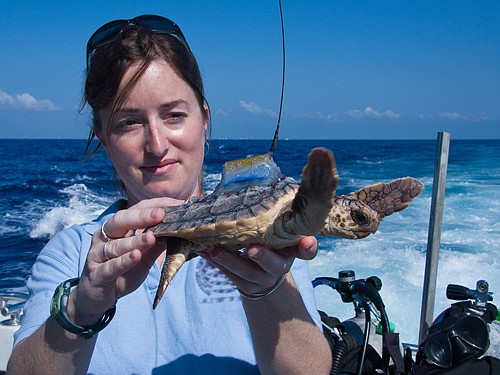- April 26, 2024
-
-
Loading

Loading

A lingering mystery surrounding one of the oldest creatures in the ocean could soon be unlocked with UCF leading the way.
Research conducted by a team of professors and scientists led by UCF professor Kate Mansfield revealed first-of-its kind data regarding the migration patterns of sea turtles between hatching and returning to the coast – a curious gap in knowledge that experts refer to as “the lost years.”
The team – combining expertise from UCF, Florida Atlantic University, University of Miami and University of Wisconsin – used Mansfield’s satellite tracking devices to keep tabs on a group of 17 loggerhead turtles swimming off the coast of Florida for spans of 27 to 220 days.
Their findings showed that the turtles traveled to the middle of the Atlantic Ocean or the Sargasso Sea, contradicting existing theories that the creatures only followed the currents in a great circle around the perimeter of the Atlantic.
Sensors on the tracking devices also showed that the turtles’ shells were considerably hotter than anticipated, leading Mansfield and her team to a new theory for why the young turtles take shelter in the Sargassum seaweed found on the surface of the open ocean.
“Perhaps the turtles are opportunistically associating with Sargassum,” Mansfield said. “We know that they do and if some of them happen to find a floating Sargassum mat and stick with it, why leave? You’re getting shelter and you’re also having access to food.”
“The turtles gain some sort of thermal benefit from this…if they’re living within optimal warm temperatures then their metabolism may be really efficient and it would promote growth and feeding behavior, among other things.”
The team’s discovery was published in March by Proceedings of the Royal Society B, a biological research journal.
It’s the first glimpse into a mysterious window of time that starts right after a sea turtle hatches, Mansfield said. After they scramble across the sand and back into the ocean, the turtles embark on a migration pattern that can last several years before returning to the coast.
What happens in the open water has remained a mystery. Mansfield said that everything researchers know about the oceanic stage is either inferred, taken from replicated environments in laboratories, or found through opportunistic sightings.
The professor began using her satellite tracking method five years ago, attaching the devices to the shells of young, year-old turtles to collect data. She’s used the devices to track loggerhead, green, Kemp’s ridley and hawksbill turtles in the Gulf of Mexico, the northwest Atlantic, along the U.S. Atlantic coast, and in the south Atlantic off the coast of Brazil.
Mansfield hopes that learning more about the lost years will enable conservationists to better protect the turtles from human impact.
“Once we have a better idea of where they are, what they’re doing and what they’re migration patterns are, we can start looking at fishing activity or other human activities that may overlap with those turtles and better understand if there are impacts that humans may have on the turtle population,” she said.
Mansfield joined the UCF faculty last summer to head the Marine Turtle Research Group, which monitors sea turtle nests and tracks juvenile turtles along the coast.
She arrived near the end of a record-setting turtle nesting season in Florida last year. At the Archie Carr National Wildlife Refuge, a 13-mile stretch of beach in Brevard County where the UCF Marine Turtle Research Group collects their field research, at least 11,500 green turtle nests were found that year – more than double the previous record of 5,000 green turtle nests seen in 2011.
The increasing population means more subjects that can be tracked for research, said Kendra Cope, a graduate student in the Marine Turtle Research Group.
“Those numbers have been phenomenal,” Cope said. “It’s been such a great blessing to work on a project where we can see such an exponential increase in the population.”
Mansfield’s contribution of information on the lost years helps complete the life cycle research program within the UCF research group, a body of work that the professor hopes will lead the way in understanding all there is to know about sea turtles.
“Hopefully we’ll be one of the few places in the world that will study all aspects of the sea turtle life history with field work, among other things,” Mansfield said. “It’s pretty exciting.”
Having the complete picture of the turtle life cycle is crucial to keeping their population growing, said Llewellyn Ehrhart, a professor emeritus who headed the Marine Turtle Research Group for more than 30 years and advocated for the creation of the Archie Carr National Wildlife Refuge in 1991.
“The chain is only as strong as its weakest link,” Ehrhart said. “You can use that analogy for our conservation effort for sea turtles; it’s only as good as the part that we know the least about, because turtles are such international animals.”
Mansfield looks forward to continuing her research while following the number of sea turtle nests at the refuge.
“I’m excited to see what’s going to happen in the next couple of years, let alone the next 20 years,” Mansfield said.